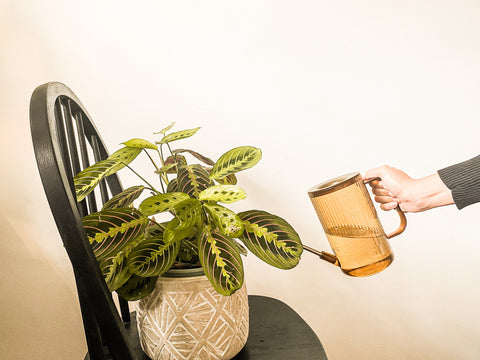Prayer plants are a fascinating species that you won't come across in every home. Their distinctive, quirky personalities are one of a kind, with their leaves moving continuously throughout the day. Even though my own prayer plant has startled me more than once with its sudden movements, I find it endearing and a true testament to the fact that plants are living beings.
Apart from their endearing mannerisms, these plants are a true feast for the eyes, boasting intricate and stunning leaf patterns. In this article, we'll delve into everything you need to know about prayer plants: their different types, how to care for them, how to incorporate them into your decor, and what makes them so special.
What are Prayer Plants?
Prayer plants are a fascinating species belonging to the Marantaceae family, which are tropical plants typically found in Central and South America. What sets them apart are their striking decorative leaves, which display an array of bright greens and deep crimsons. These unique leaves are capable of folding upwards during the night, creating the impression of hands clasped in prayer, giving these plants their distinctive name.
Despite their delicate appearance, prayer plants are surprisingly easy to care for, making them a beloved addition to any indoor garden. They also have the added bonus of purifying the air and having a soothing effect on their surroundings, making them a popular choice for those seeking a calming natural element in their homes.
Types Of Prayer Plants
There are many distinct types of prayer-plants that are all part of the Maranta family. However, apart from the Red Maranta, the rest of the prayer-plants are quite hard to come by and even harder to care for.
Some of the prayer plant varieties include: Maranta Lemon Lime, Red Maranta, Green Maranta, Silver Band, Black Maranta, Cat Mustache, Maranta Cristata, and Variegated Arrowroot.
The leaves of the prayer plant move in response to changes in temperature, as well as touch. This movement is known as “nyctinasty”, and it is believed that this response helps protect the plant from extreme temperatures, as well as predators.
Interesting Facts About Prayer Plants
The leaves of the prayer plant move in response to changes in temperature, as well as touch. This movement is known as “nyctinasty”, and it is believed that this response helps protect the plant from extreme temperatures, and predators.
Prayer plants are sometimes used in their native regions to cure ailments like fever, wounds, and digestive issues.
Good news for pet parents: Prayer plants are considered non-toxic to both cats and dogs, making them a viable decor element in a pet-filled home.
Prayer plants are remarkably adaptable to low-light indoor environments, which is where they really shine. In fact, it's in these subdued lighting conditions that they often appear the most vibrant and dynamic, with their leaves reaching upwards as if in constant prayer.
Prayer plants are sometimes used in their native regions to cure ailments like fever, wounds, and digestive issues.
Good news for pet parents: Prayer plants are considered non-toxic to both cats and dogs, making them a viable decor element in a pet-filled home.
Prayer plants are remarkably adaptable to low-light indoor environments, which is where they really shine. In fact, it's in these subdued lighting conditions that they often appear the most vibrant and dynamic, with their leaves reaching upwards as if in constant prayer.
Benefits Of Prayer Plants

1. Air Purification
Like most indoor plants, prayer purifies the air by removing toxins and pollutants, which in turn makes for a much healthier indoor environment.
2. Calming Effects
The gentle, graceful movements of the prayer plant throughout the day have been known to have a soothing and almost mesmerizing effect on those who observe them. Watching the leaves fold and unfold in response to changes in light and temperature can be a meditative experience, providing a moment of peace and relaxation in a busy day.
3. Aesthetically Pleasing
The prayer plant is widely regarded as one of the most visually striking houseplants available today. Its intricate leaf patterns and vibrant colors are a feast for the eyes, adding a touch of natural beauty and elegance to any interior.
4. Easy To Care For
The prayer plant is surprisingly very easy to care for. They are very drought-tolerant, so they don’t require nearly as much watering as most houseplants. I use a wick to water my prayer plant from below, only taking what it needs, which makes it exceptionally low-maintenance.
5. Pet-friendly
Fortunately for pet owners (yet maybe not so fortunate for the plant), the prayer plant is non-toxic to both cats and dogs, making it a safe and worry-free choice for those with furry friends in the house. While some plants can pose a risk to pets if ingested, the prayer plant is completely harmless and can provide a safe and healthy environment for both you and your animal companions.
Want to know which plants are harmful to your cat? Read my blog post on Plants That Are Toxic to Cats.
How To Care For Prayer Plants

1. Light Requirements
Although prayer plants prefer bright, indirect light, they are very tolerant to low light (and the lower the light, the prettier the leaves appear). However, avoid direct sunlight, as harsh sunrays can scorch their delicate, thin leaves.
2. Soil Requirements
Prayer plants prefer a rich, well-draining soil.
3. Watering Requirements
Remember that prayer plants are very drought-tolerant, which means that you should only water them once their soil is completely dry. Overwatering can lead to root rot. Make use of the wick watering system, as watering them from underneath means that they will only consume water as needed.
4. Temperature Requirements
Being tropical plants, prayer plants prefer warmer temperatures of about 16-27°C (0-80°F). Keep your prayer plants away from windows and doors, as they are very sensitive to cold drafts.
5. Fertilization
Make sure to feed your prayer plant a water-based fertilizer at least once a month during the growing season (spring and summer). Refrain from fertilizing during autumn and winter.
6. Humidity
Again, because prayer plants are of tropical descent, they prefer a high humidity level. Make sure to regularly mist your prayer plant, and place them next to a humidifier, or in a high-humidity room like the bathroom.
7. Common Problems and How to Solve Them
- The most common problem in prayer plants is yellowing leaves. This can be the result of multiple issues such as overwatering or underwatering, or due to cold temperatures and low humidity levels.
- Brown tips on leaves: Up the humidity level and water your plant more regularly.
- Wilting leaves: This could be due to lack of watering, or due to exposure to direct sunlight or very cold drafts.
- Pests: Prayer plants are prone to mealybugs, scale insects, and spider mites. Regularly check your prayer plant for webs, or little white lumps, and take action immediately by isolating the plant and treating it with neem oil.
- Root rot: This is most likely due to poor drainage. Make sure that your plant is in well-draining soil that is dried out between waterings.
Propagating Prayer Plants

1. Soil Propagation
- Cut a stem from a healthy prayer plant (must have several leaves on it) by making use of a sharp knife or scissors.
- Make sure that the stem has at least one node.
- Remove the leaves from the lower stem, leaving only leaves at the very top.
- Fill a small pot with standard potting soil.
- Dip the cut end of the stem in a rooting hormone.
- Plant the end of the stem in the middle of the pot.
- Water the plant.
- Place the plant in a warm, light-filled spot, but not in direct sunlight.
- Wait for new leaves to form, indicating that new roots have grown from the node.
- Once the plant looks established with a few new leaves, transplant it into a larger pot.
2. Water Propagation
- Cut a stem from a healthy prayer plant (has to have several leaves on it) by making use of a sharp knife or scissors.
- Make sure that the stem has at least one node.
- Remove the leaves from the lower stem, leaving only leaves at the very top.
- Dip the cut end of the stem in a rooting hormone.
- Place the stem in a vessel filled with water, ensuring that the water is well above the node of the plant, yet not touching any of the leaves.
- Place the plant in a warm and sunny spot and regularly refill it with clean water.
- Once you see that a few roots of at least two inches have started to form, it is safe to take the plant out and plant it in the soil.
- Remember to frequently water for the first week or two, as the roots are now used to being saturated in water.
3. Tips For Successful Propagation
- Propagate during the growing season (spring and summer).
- Only propagate from a healthy plant.
- Dip the cut end of the stem in a rooting hormone to increase the chances of successful propagation.
Using Prayer Plants In Home Décor
After you've learned about the different types of prayer plants and how to care for them, it's time to look into how you may incorporate these unusual plants into your home décor. Prayer plants are a fantastic addition to any interior décor concept due to their gorgeous foliage and easy-care nature. Let's look at some unique methods to display these plants in your home.
Decorating Ideas Using Prayer Plants
Hanging baskets: Although not necessarily a “trailing” plant, prayer plants grow exceptionally long stems, which makes them great for trailing down from a hanging basket. Hanging plants can be a pain to water, which makes the prayer plant the perfect plant for hanging, as it is a very low-maintenance plant that requires minimal watering.
Table centerpiece: With their delicate and intricate foliage, prayer plants can make stunning centerpieces reminiscent of a beautiful bouquet. Consider placing them in a subtle container to let the foliage shine and create a natural, organic feel to any room.
Shelf accent: Prayer plants tend to grow very directionally, as they are extremely sensitive to light. This makes it a great plant for placing on a shelf, against a wall.
Wall art: Add some flair to your bare walls with a prayer plant wall art piece. Whether you choose to purchase one or create your own, this unique plant makes for a stunning and eye-catching piece of green artwork.
Best Rooms for Prayer Plants
Being as versatile as they are, prayer plants have the unmatched ability to thrive wherever you place them in your home, providing it’s not near a drafty window. However, there are certain areas where the prayer plant can absolutely thrive, especially if these rooms have low to moderate light level. The best rooms for prayer plants include:
Bedroom: The prayer plant is perfect for the bedroom since it has a calming effect on people. Who wouldn't want to sleep with a peaceful green companion by their side?
Living room: n the other end of the spectrum, prayer plants have a lively and playful quality to them that can make them an excellent addition to the living room. They dance and sway with their foliage, adding a sense of movement and vibrancy to the space. Since we spend so much time in the living room, it's the perfect spot to showcase this beautiful and captivating plant.
Bathroom: Because of its tropical nature, the prayer plant enjoys high humidity levels. The bathroom is one of the rooms in the house with the highest humidity for your prayer plant to enjoy. And what better thing to look at than a prayer plant while taking a long and luxurious bath?
Kitchen: Speaking of humidity, the second most humid area in the house tends to be the kitchen. Aside from your prayer plant loving the humidity, it’s a great plant to have in the kitchen for its air-purifying properties.
Home office: Also because of its air-purifying quality, the prayer plant makes a great study buddy for the home office, especially if this is the room where you spend most of your time during the day.
Prayer plants are a fantastic addition to any interior, regardless of what species you decide to purchase, or how to display it. At the end of the day, they are great conversation pieces that aren’t only beautiful to look at but add to our health and well-being by removing harmful toxins from the air. I hope you now feel confident enough to purchase that prayer plant you have been eyeing at the plant store and successfully care for it and enjoy it for years to come.





